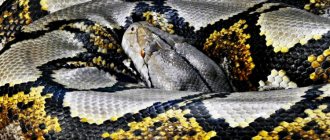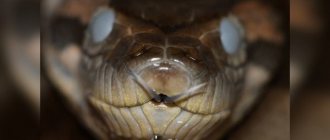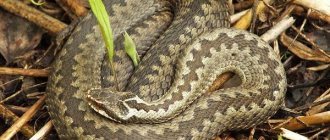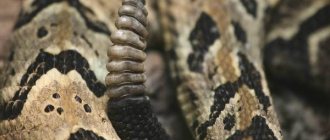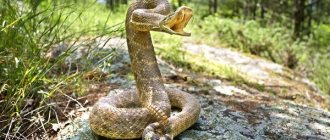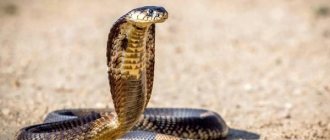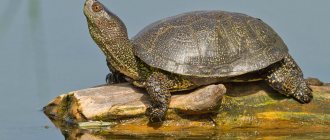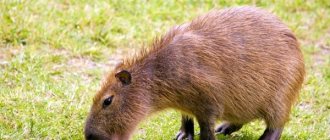Description and features
Most often, these reptiles are medium in size, up to 1.2 m. Although sometimes they can reach 2.4 m in length. They have textured scales with ridges. In the photo it looks like a skillfully twisted chain, its scales fit so tightly. There are internasal shields on the head. The pupils are round, the nostrils are directed to the sides and upwards. The belly is spotted. The anal shield is divided.
Let's add to the description the distinctive quality of one of the colubrids - the common grass snake. It is most common among us. These are the famous yellow spots on the head that make it immediately recognizable. The color of the spots can be orange, light yellow, slightly beige, even almost white. We understand one thing right away - these spots show that this is not a poisonous snake. Other snakes do not have such spots.
Their body is thin and flexible, their head is small, and their neck is clearly defined. The tail is pointed at the end. Numerous teeth sit on the jaws and on the roof of the mouth. The teeth on the upper jaws increase towards the depths of the mouth, the latter being especially large. There are no rudiments of pelvic bones in the skeleton. They have an almost ideal body shape that we consider typical for snakes.
The snake can be called an intelligent creature; it differs from most other reptiles in its intelligence. And mobility, of course. There is a common expression: “Nimble as it is.” We are often asked the question: is there a poisonous snake similar to a snake ?
Yes, this is a viper that is dangerous to humans. However, they can be distinguished by certain characteristics:
- First of all, it is the shape of the body. Much slimmer, one might say, “more driven.”
- The viper has a zigzag stripe on its back, but the snake does not have it. In addition, many snakes have the notorious yellow spots on their heads.
- Their head shape is also different. The snake's is oval, slightly ovoid, the viper's is triangular, resembling the tip of a spear.
- The pupils of the viper's eyes, like all poisonous ones, are in the form of transverse slits; the pupils of the snake are closer to those of a cat.
- If the snake opens its mouth and it is clear that it has two fangs, it is a viper. The snake has no poisonous fangs and small teeth.
- If the snake hisses threateningly and is in no hurry to escape, it is definitely a viper. Snakes are usually peaceful.
- Vipers do not like frogs, they like rodents, and on the contrary, they prefer amphibians.
From all of the above, you need to understand that if you remember well what a snake looks like , you can easily distinguish it from its poisonous counterparts.
Physiology of male and female
It is almost impossible to distinguish a male from a female by external signs. The only external sign is that the females of most species are smaller than the males and are not as brightly colored. But for example, the female anaconda is larger than the male, so size is not an accurate sign for determining sex.
The sexual characteristics of snakes are hidden inside the body. The male's paired fertilization organs, the hemipenises, are hidden in special pockets in the abdominal cavity, closer to the tail. In the presence of a female who is ready to mate, the hemipenes enlarge and become ready for mating.
It is noteworthy that only one of them is used during mating. But if there is another lady nearby, then there will definitely be an opportunity to use the second one.
Important! During the breeding season, snakes are most aggressive, and the female’s attraction of many males from throughout the surrounding area makes a chance encounter with reptiles even more dangerous.
The female's paired genital organs, the hemiclitors, are not visually visible and are located inside the body. The readiness of a female to mate is indicated by the pheromones she secretes. The male is able to sense them from a distance of several kilometers.
Kinds
The snake is a genus of non-venomous snakes of the Colubridae family. The name “uzh” itself originated in the Slavic language; in other languages it is pronounced differently. But everywhere it means a snake in the general sense. Therefore, for a long time, herpetologists classified snakes as them, which were difficult to classify as other families. This is how this family expanded due to discarded species.
In our country, the common and water snakes are the most common, and the viper snake is also found. There are 4 species in the genus of real snakes. These are three of the above and an even bigger head snake. The previously mentioned Aesculapian snake is now called the Aesculapian snake; it also belongs to the colubrids.
1. The most familiar to us is the ordinary one . It is an aquatic animal, swims well and hunts in the aquatic environment. Found throughout Europe and Asia, excluding the Far North. Prefers dense thickets on river banks, in swamps, or in forests where the soil is moist. It can be found on old dams.
They often settle close to a person if he lives near water. It can crawl right into the house, into the cellar, or hide in the yard in a pile of garbage. Its size is about a meter, but it can reach up to 2 m. Females are much larger than males.
It is painted in a dark gray, marsh or almost brown color, sometimes with a pattern similar to a chessboard. The belly is light gray, almost white, with a dark stripe along the body. Among them there are albinos and melanists (white and black).
2. The merman no longer has yellow spots on its head. In this place it has a dark V-shaped spot, pointing forward. It is colored almost like an ordinary one, in green and brown tones, with a checkerboard pattern on the body. Leads an aquatic lifestyle. It feeds only on fish and amphibians.
3. The adder snake is not a poisonous snake. He looks most like a viper; he even has a zigzag pattern on his back, although sometimes these can be numerous spots arranged in an intricate manner. But it is smaller than a viper, and unlike it, it has a satiny sheen to its skin. The viper's skin looks dry and rough. It is found in the Mediterranean, in the west and south of this region.
4. The big-headed snake (Colchian) lives in the Caucasus. It differs from the usual one with a wide head. It is a completely black grass snake , with light spots on the back of the head in adults. It prefers river rapids, while the common snake loves calm water. The eggs are larger than the first one.
At the moment, colubrids also include snakes, copperheads, forest snakes, lizard snakes, long-toothed snakes, cat snakes, climbing snakes, dinodons and eirenis. However, the taxonomy of these snakes is very complex. Recently, scientists have been moving away from a general listing of snakes, increasingly distributing them into other families, mainly the slates.
And to close the topic, let’s add that there are poisonous snakes, which are usually called snakes, these are false snakes or dorsal grooved snakes. Their poisonous teeth are located in the depths of their mouth, behind all the others. Their poison is dangerous for small animals, but is not lethal for humans and has a paralyzing effect. Only they, too, should rather be classified as slates.
Natural enemies of common snakes
Photo: Ordinary
The colubrid family has many enemies, because these snakes are not poisonous. Various predators are not averse to feasting on the snake, so it can become a snack for foxes, raccoon dogs, hedgehogs, weasels, badgers, martens, and minks. Many birds attack grass snakes, so it can be eaten by a stork, snake-eagle, kite, or heron. Large rodents, such as rats, can also grab a snake, especially a young and inexperienced one; moreover, they often destroy dinner nests by eating snake eggs.
Surprisingly, frogs and toads, which themselves become dinner for snakes, often eat small snakes. Insects such as ants and ground beetles destroy dinner eggs. Large fish, for example, trout, can also eat small snakes. Some other snakes also eat snakes.
In defense, it tries to pretend to be a poisonous reptile: it slightly flattens its neck, makes a hissing sound, folds itself into a zigzag, nervously twitching the tip of its tail. This is how he tries to make a terrifying impression on his ill-wisher, but if there is an opportunity to sneak away, then he, of course, does not miss it, first of all, preferring this particular option.
Interesting fact: When caught, the snake pretends to be dead or secretes a very foul-smelling secretion, thanks to its cloacal glands. With such maneuvers he tries to divert danger from himself, because in the struggle for life all means are good.
Snakes often become victims of a person who can kill them just like that, for no particular reason or by mistaking them for a viper. Since these reptiles do not avoid human settlements and often live next to humans, they often fall under the wheels of cars. So, snakes have a lot of enemies in natural conditions, especially young animals are at risk, so reptiles have to always be on the alert, and at twilight they hide in their secluded shelters.
Lifestyle and habitat
Snakes swim and dive well, so they live where there is water. Although they are also found in dry areas. Their address is planet Earth. In any corner, except the polar regions, you can find snakes.
For the most part, they are diurnal animals, quite fast and agile. At night they try to hide quickly. From this behavior it is clear what he is afraid of . If he does not hide until night, he will quickly cool down and will not be able to move normally. Then he will become easy prey for other animals.
And many animals, birds and reptiles are ready to offend. Let's not talk about obvious predators such as a fox, raccoon or hedgehog. It can become prey for 40 species of birds. Any large snake can eat it, a rat, a toad, even a trout will not hesitate to attack a small snake. Yes, and some insects can harm him. Ground beetles and ants destroy its eggs.
It is interesting to watch the agile reptile on the shore of a reservoir. Here he lies almost motionless, basking in the sun. And in the blink of an eye, a small arrow, like a drop of mercury, slid into the river. Swims underwater, with only one head slightly raised above the surface. It can be completely submerged in water; snakes can remain at depth for a long time.
Often, trying to escape from an enemy, it hisses, flattens its neck, folds its body in a zigzag, nervously twitches the tip of its tail, so that the offender wonders whether this snake is poisonous or not . Maybe you shouldn't contact him? A minute of reflection is enough for this reptile to quickly slip away.
If you have a farm near a pond, you can find a grass snake in the poultry house at any time. They feel comfortable and warm among the birds. There have been cases where snakes have laid their eggs in an abandoned duck or chicken nest. They do not like to live in other outbuildings - in stables or barns, apparently fearing that they will be trampled.
Reptiles can be found in the park, in city wastelands, and on the beach. They can also crawl out into the city, and then often die under the wheels of cars. Sometimes you can catch a snake; it is gentle, trusting and curious.
If you pick up this animal, be prepared for the unpleasant odor it may release. He also tends to pretend to be dead. In captivity, the captive quickly gets used to it and becomes almost tame.
The habitat where the snake lives
This is the most common snake in Eurasia. There must be a body of water where the grass snake lives. This is the main condition for his comfortable existence.
The reptile does not like cold, harsh climates. In northern latitudes, its habitat is limited to Karelia. Snakes can be found in America, Oceania and Australia.
Non-venomous snakes live in Africa, in the northern part of the continent. Their advance deeper into the continent was stopped by the Sahara. Although there are also species that live in sands, in arid climates.
Snakes prefer bodies of water with standing water: ponds, lakes, swamps. They can live near rivers with gentle currents.
In addition, these snakes can be found in atypical places. They are found in city parks, forests, meadows, mountains, and beaches.
They are unpretentious and adapt to different places and natural areas. Snakes do not mind settling next to a person. They often create secluded nests for themselves right in the courtyards of private houses.
Nutrition
Their food consists mainly of small vertebrates, amphibians and reptiles. Some snakes prefer rodents, birds and fish. Favorite food is frogs. They catch them both on the shore and right in the water. It must be said that the frogs almost do not see the danger in him and let him get close enough.
Having grabbed the prey, the hunter tries to swallow it alive. It can open its mouth quite wide, like other snakes. This is a great help when hunting for fish. It quickly slips into the predator's throat. But with a frog it’s more difficult. Sometimes the most agile and large frog manages to escape from the mouth, leaving one of its paws there.
Being stubborn, he achieves a successful end to the hunt by pursuing the fugitive. He eats up to 5-6 small grass frogs to get enough. If you are very hungry, tadpoles are used; the snake swallows a lot of them at a time, the total number reaches 100 pieces.
If you compile the diet of this animal, you will get the following list: newts, toads, frogs, lizards, chicks that have fallen from the nest, small water rats, insects and their larvae. This reptile never eats carrion, but loves milk very much. In the villages they cooled milk in jars and put snakes in them. It was believed that it did not turn sour for a long time after this.
Their main hunt is in the morning and evening, until it is very dark. During the day, in bright sunshine, they prefer to lead a sybarite lifestyle. Reptiles lie on stumps, hummocks, stones, fallen trunks, basking in the sun. At night they hide in a shelter. Any hole or depression is quite suitable for this purpose. If you have a snake at home, learn some rules for keeping this reptile:
- You need a terrarium with a thermal cord or thermal mat in the corner. His favorite temperature is 30-33 degrees Celsius.
- Lay gravel, paper or coconut in the container.
- It is necessary to create 2 shelters for him in a warm and cold corner. Place a ditch with wet sphagnum in a warm one; the cold one should be dry.
- He needs a large container for water, he drinks a lot and loves to swim.
- Install additional lighting (UV lamp), turn it on when there is little sun.
- If you want, on the contrary, to euthanize your pet in winter, try to reduce daylight hours.
- Feed him 1-2 times a week with frogs, small fish, preferably live ones. He won't eat dead people.
- Sometimes snakes are accustomed to defrosted foods.
How to Avoid a Bite
Already hidden in the grass
To avoid causing harm to a person, you just need to not touch him.
To do this, you should be careful when being in natural conditions:
- do not walk barefoot on tall grass, especially along river banks or wetlands;
- do not pick up branches and leaves with bare hands;
- when picking mushrooms and berries, you need to use a stick to rake the forest floor;
- do not create garbage heaps in the garden plot from trimmed cultivated plants that lie for a long time without disposal;
- fight frogs and rodents;
- Do not provoke the discovered animal with a stick or other objects, trying to get a better look at it.
Important. The surest way to encounter a snake is to move a few meters away from it. A snake or another reptile never attacks first, but only for the purpose of its own protection.
Reproduction and lifespan
Snakes are oviparous. They reach puberty at 3-4 years of age. The mating season lasts 2 months of spring, April and May. The exact time is different everywhere, but the algorithm is similar for all snakes. They crawl out after hibernation, catch their first spring prey, shed their old skin and begin mating games.
The process involves several males and one female. In this tangle it is difficult to understand which of them is the father. Perhaps there are several of them. The result of this polygamous union is the laying of about 100 eggs. Snake eggs are similar in shape and size to pigeon eggs and are covered with a soft, leathery shell.
They consist mainly of yolk, little protein, just a thin shell. The female lays eggs only in a sheltered place, in piles of leaves or buries them in damp soil. If they are left on the surface, they will dry out, and if placed in water, they will also die. This is where her concern for her offspring ends. She doesn't hatch it.
The eggs come out one by one, bound by a gelatinous substance. All this looks like exotic beads or rosaries. Eggs in some areas are also credited with magical properties. In some places they are called “rooster eggs.” They are said to be healing and help against the evil eye.
After about 21 days, the cubs, abandoned to their fate, break through the shell themselves, crawl out and begin an independent life. The little ones are up to 15 cm long and already have teeth. They feed on insects, worms and snails. Snakes live a long time from 19 to 23 years. And the main condition for their long-term residence is the proximity of water.
Symptoms
Dangerous consequences develop if a person develops an allergic reaction to the saliva of a reptile. Most people compare a snake bite to an injury from a cat's claws. Teeth marks appear on the body - red dots. Slight hyperemia and edema may be observed in this area. The first few minutes after the bite, blood will ooze. The discharge can be quickly stopped. The difference between a poisonous snake bite is that a person additionally experiences a strong burning sensation at the site of injury. Pain appears within 10–15 minutes.
If a person develops an allergic reaction after being bitten by a grass snake, the swelling will be more pronounced. In addition, itching will appear at the site of the bite. To avoid complications, the patient must receive medical assistance as quickly as possible. There is a high risk of developing angioedema.
I personally had to deal with a situation where, after being bitten by a snake, my brother’s leg became very swollen. The swelling subsided within 20 minutes after taking the antihistamine, even before the ambulance arrived.
At the site of the bite you can see puncture points from teeth
The bite of a tiger snake poses a great danger to health. These snakes have venom in their back teeth. There have even been recorded cases of death after a bite from such a reptile. The poison is especially dangerous for children and pregnant women. The patient exhibits signs of severe poisoning, such as:
- severe itching in the bite area;
- labored breathing;
- muscle spasms;
- limb spasms;
- significant increase in body temperature;
- general weakness and dizziness.
Symptoms will be more pronounced in weakened patients, as well as people prone to allergic reactions.
Why do you dream
In dreams it often appears as a positive object. His favorite pastime - basking in the sun in a dream - means that good news awaits you. If you feed a snake in a dream, in reality you will be appreciated, you will receive profit, reward or recognition. For women, seeing a snake in a dream means a change for the better in their personal lives.
Either you get married or meet your betrothed. If a snake bites you, expect the desired pregnancy. For men, this snake is not so supportive; more often, meeting a snake in a dream means deceit and deception in life. It is very important to remember all the circumstances of the dream in order to understand why the snake is dreaming.
Our subconscious desires sometimes reveal a puzzle in our dreams. But our feelings are difficult to deceive. If after such a dream with a reptile you do not have any unpleasant impressions, feel free to greet the day. This dream is always for the better.
First aid for a snake bite
It is possible that the injury was caused by a viper or tiger snake. Therefore, the algorithm of actions should always be the same. First of all, you need to call an ambulance or try to transport the patient to a medical facility yourself.
If you are not sure that the bite was caused by a snake, you should try to suck out the poison from the wound. This must be done in the first seconds of the incident. You need to press on the area around the wound with your fingers and begin to vigorously suck out the poison, spitting periodically. These actions should be performed for 10–15 minutes. Thanks to correctly provided first aid, it is possible to remove part of the poison.
Proper antiseptic treatment of the wound is important
To avoid infection, the wound must be carefully treated:
- Wash under running water and soap.
- Treat with an antiseptic. Hydrogen peroxide, Miramistin, Chlorhexidine are suitable.
- If swelling is present, apply ice or another cold object.
- Treat the area around the wound with iodine.
- Allergy sufferers are advised to take an antihistamine (Tavegil, Diazolin, Suprastin).
Hydrogen peroxide will prevent the growth of bacteria in the wound
If a person is absolutely sure that he was bitten by an ordinary snake, it will be enough to carry out the correct antiseptic treatment of the wound. Even if the symptoms are not pronounced, in order to avoid unpleasant complications, you should consult a doctor. If a reptile has bitten a child or a pregnant woman, there can be no question of self-medication. It is necessary to get to a medical facility as quickly as possible.
It is strictly forbidden to cauterize the bite site or try to cut the affected area to quickly remove the poison.
Interesting Facts
- In the Urals there is a legend about the “dinner king”. They say that if a snake has already crawled into a house, it means prosperity. You can’t kick her out, you have to feed her milk. If you offend the reptile, the dinner king will bring disaster to this house.
- Snakes love to swim for a long time, sometimes simply without a purpose. They like the ritual itself. Usually their trajectory runs along the shore, but sometimes they can be found in the center of a large lake, even in the open sea.
- After being completely full, can go without food for a long time, sometimes not even days, but months. It is difficult to understand why, but one German naturalist decided to conduct an experiment and did not feed for 10 months. Finally the “terrible” hunger strike ended and the poor animal received food. Incredibly, this test passed for him without any special consequences.
- If at the time of oviposition there are few secluded places in the territory, and there are many mothers, they set up a “nursery”. They make general masonry. Scientists once saw such a collective storage facility in a forest clearing; there were about 1,200 eggs there.
Everyone wants to bask in the sun
After the winter, tired of the grayness and cold, people flocked to nature. Picnics, fishing, walks through fields and forests in search of adventure can not only delight you with flowers, fresh air and beautiful landscapes. Reptiles crawl out of the thicket to bask in the sun. Thank God, we have only one or two species of snakes. But in order not to end up in the hospital, you need to study their habits.
The smartest thing to do when you see a snake is to simply leave the animal alone. It is not necessary to find out who exactly you noticed and come closer. However, there are all sorts of situations, and it doesn’t hurt to know the potential “villain” by sight.
Mangrove snake
The mangrove snake has masses of yellow stripes on a massive black body. The body length of the mangrove snake is generally 2-3 meters, the head is faintly visible, just like that of snakes.
During the daytime, snakes prefer to rest in trees; the rest of the time they hunt for birds, lizards, rodents and other living creatures.
Note!
Domestic turtles - the most popular species, cultivation features, tips for care and maintenance (115 photos + video)- Indian snakes: sacred, poisonous, most common and dangerous types of Indian snakes and their names (130 photos)
Small snakes - an overview of popular and rare species, habitats, food and names of snakes (115 photos)
The bites of this snake are not fatal, but quite dangerous. So, the consequences of an attack by this creature include severe pain, swelling, fever and general malaise.

